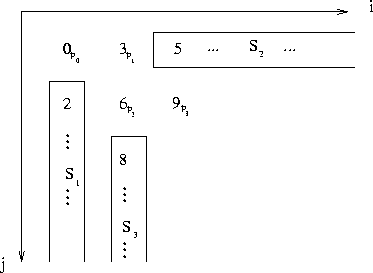The same processor executes both successors. They are executed sequentially and the last one being executed cannot begin execution before time-step
(respectively proc(I) = proc(I'') and
This case is similar to the previous one.
Let proc(I) be the processor that executes tile I. We have three cases to consider, depending upon whether proc(I) also executes both successors I' and I'', or exactly one of them, or none of them:
Back to the proof of the theorem, let
![]() the total execution time using P processors. Let Idle be the cumulated idle time of all processors during execution. Finally, let
the total execution time using P processors. Let Idle be the cumulated idle time of all processors during execution. Finally, let ![]() be the sequential execution time. Clearly,
be the sequential execution time. Clearly,
![]()
Hence, to show that ![]() , we need to show that
, we need to show that
![]()
The structure of the dependence graph does impose that some processors are idle
at the beginning of the computation, which will lead to
a lower bound for Idle. For instance, during the execution of tile (0,0),
there are necessarily P-1 idle processors. To go on, we
recursively define ![]() as follows (see Figure 5):
as follows (see Figure 5):
We prove by induction that for ![]() , at least P-k processors are kept idle between the beginning of the execution of
, at least P-k processors are kept idle between the beginning of the execution of ![]() and that of
and that of
![]() . This will lead to be result that
. This will lead to be result that
![]()
This will prove the desired result, because the same amount of idleness, so to speak, will be spent at the end
of the computation (by symmetry of the dependence graph).
Now, for the induction:

Figure 5: A schedule when ![]() and
and ![]() .
Pivot tiles are labeled, and sets S(k)
are framed.
.
Pivot tiles are labeled, and sets S(k)
are framed.